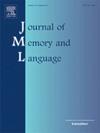Do syntactic and semantic similarity lead to interference effects? Evidence from self-paced reading and event-related potentials using German
IF 3
1区 心理学
Q1 LINGUISTICS
引用次数: 0
Abstract
Cue-based retrieval accounts of sentence processing postulate that at a verb, retrieval cues are generated to complete a dependency with the verb’s argument(s); for example, the dependency between the subject and the verb must be completed. If these retrieval cues match with not only the subject but also with those on other nouns in the sentence, then processing difficulty arises at the verb. This difficulty in identifying the correct dependent is called similarity-based interference. We present relatively large-sample self-paced reading and event-related potentials experiments using a well-established design to investigate interference due to syntactic and semantic cues in German. In this design, the syntactic cue {+subject} and the semantic cue {+animate} are manipulated. Bayes factors analyses showed evidence for a semantic interference effect in both experiments. Surprisingly, Bayes factors provided evidence against interference due to the syntactic cue {+grammatical subject} in this particular design in both experiments. This finding contradicts the predictions of the standard implementations of cue-based retrieval theory, which (implicitly) assumes that both syntactic and semantic cues play an equal role in retrieval. We show through computational modeling that cue-based retrieval will also show no syntactic interference in the present design if the parser is assumed to keep track of which clause the subject occurs in. Thus, if syntactic retrieval cues include hierarchical syntactic information (is the noun in the same clause as the verb?), the cue-based retrieval model would exhibit patterns consistent with the observed patterns in our data.
语法和语义的相似性会导致干扰效应吗?使用德语进行自定节奏阅读和事件相关电位的证据
基于线索的句子处理检索帐户假设,在一个动词,检索线索被生成,以完成与动词的参数的依赖关系;例如,主语和动词之间的依赖关系必须完成。如果这些检索线索不仅与主语匹配,而且与句子中其他名词的检索线索匹配,则在动词处出现处理困难。这种识别正确依赖的困难被称为基于相似性的干扰。我们提出了相对大样本的自定节奏阅读和事件相关电位实验,使用一个完善的设计来调查由于句法和语义线索在德语中的干扰。在本设计中,对句法线索{+subject}和语义线索{+animate}进行了操作。贝叶斯因子分析表明,在两个实验中都存在语义干扰效应。令人惊讶的是,在这两个实验中,贝叶斯因子都提供了证据,证明在这个特定的设计中,由于句法线索{+语法主语}的干扰。这一发现与基于线索的检索理论的标准实现的预测相矛盾,该理论(隐含地)假设句法和语义线索在检索中发挥同等作用。我们通过计算建模表明,如果假定解析器跟踪主语出现在哪个子句中,那么基于线索的检索在当前设计中也不会显示出语法干扰。因此,如果句法检索线索包括分层语法信息(名词是否与动词在同一个子句中?),那么基于线索的检索模型将显示与我们数据中观察到的模式一致的模式。
本文章由计算机程序翻译,如有差异,请以英文原文为准。
求助全文
约1分钟内获得全文
求助全文
来源期刊
CiteScore
8.70
自引率
14.00%
发文量
49
审稿时长
12.7 weeks
期刊介绍:
Articles in the Journal of Memory and Language contribute to the formulation of scientific issues and theories in the areas of memory, language comprehension and production, and cognitive processes. Special emphasis is given to research articles that provide new theoretical insights based on a carefully laid empirical foundation. The journal generally favors articles that provide multiple experiments. In addition, significant theoretical papers without new experimental findings may be published.
The Journal of Memory and Language is a valuable tool for cognitive scientists, including psychologists, linguists, and others interested in memory and learning, language, reading, and speech.
Research Areas include:
• Topics that illuminate aspects of memory or language processing
• Linguistics
• Neuropsychology.

 求助内容:
求助内容: 应助结果提醒方式:
应助结果提醒方式:


